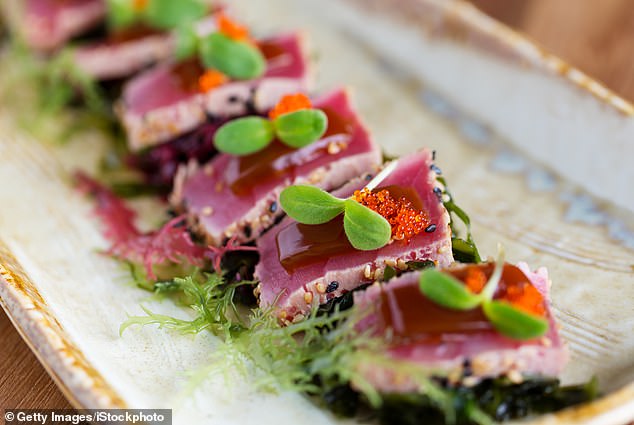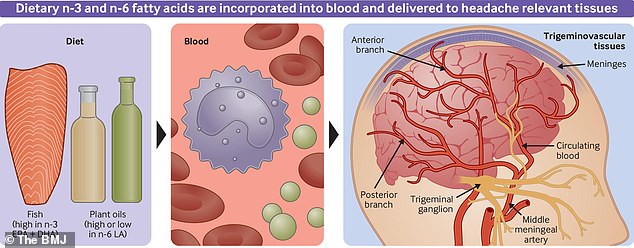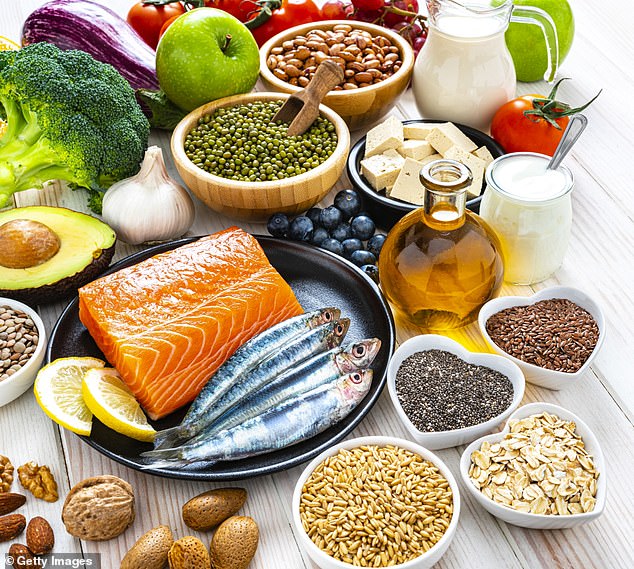Experts have revealed the best foods you can eat to stop, and potentially prevent, migraine attacks.
A migraine is a neurological condition that causes severe throbbing pain or a pulsing sensation, usually on one side of the head.
More than just a typical headache, migraines, which affect about 39 million Americans, can worsen with movement, lights and sounds and cause nausea, vomiting, numbness in limbs and vision changes.
A migraine attack can last for hours to days and a majority of sufferers are unable to work or function normally during an attack.
The severity of the pain caused from migraines may vary from person to person and can spread from the head to around the eyes, face, sinuses, jaw and neck and can interfere with regular life.
While treatments such as over-the-counter and prescription pain relievers and lifestyle changes can help deal with the pain, they can come with a host of undesirable side effects and hefty costs.
However, experts now say that eating fatty fish such as salmon, tuna, mackerel, herring, sardines and oysters, all of which are high in omega-3 fatty acids and known for their anti-inflammatory properties, can be helpful.
Kayla Farrell, a registered dietitian, told Prevention: ‘While identifying and avoiding trigger foods is important, incorporating nutrient-rich, anti-inflammatory foods into the diet can also support migraine management.’

Experts now say that eating fatty fish such as salmon, tuna, mackerel, herring, sardines and oysters help reduce migraine pain
During a migraine, the brainstem (a part of the brain connected to the spinal cord) becomes activated and triggers the release of chemicals known as neuropeptides.
These chemicals cause inflammation and swelling in the blood vessels in the brain, which leads to throbbing pain in the head, eyes, temples, neck and face.
While the pain may fade after a while, those suffering from chronic migraines may have some level of constant inflammation in their brain.
However, experts say that consuming a high amount of omega-3 fatty fish, particularly DHA (docosahexaenoic acid) and EPA (eicosapentaenoic acid), can help reduce this inflammation over time.
A 2021 BMJ study found that those who consumed diets high in EPA and DHA for 16 weeks reported about 40 percent fewer headache days per month and a decreased frequency of headache hours per day than people who had a lower intake of these omega-3 fats.
The researchers found that diets high in EPA and DHA omega-3 fats increased blood levels of oxylipin, a byproduct of omega-3s that helps reduce pain and inflammation in the brain.
Additionally, both EPA and DHA fats can reduce the production of cytokines and eicosanoids – two kinds of protein molecules that are key players in causing inflammation in the body.
Consuming these foods regularly, ideally two or more three-ounce servings per week, can help reduce overall brain inflammation with time and reduce the frequency of migraine episodes.

A migraine is a neurological condition that causes severe throbbing pain or a pulsing sensation, usually on one side of the head (stock image)
For non meat-eaters and vegans, experts suggest consuming flax seeds, edamame and avocados, which are also rich in omega-3 fats and can provide the same benefits as fatty fish.
Previous studies have linked migraines to different gastrointestinal disorders, such as inflammatory bowel disease and celiac disease.
While it remains unclear how GI disorders can lead to migraines, scientists believe that also eating fiber-rich foods such as beans, berries and apples can help ease GI pain and in turn, ease the brain’s pain receptors.
High magnesium content in foods such as brown rice, bananas and dark leafy greens can also soothe migraine pain.
According to Farrell, a 2021 study in the journal Headache found people who experienced migraines were not receiving enough magnesium, ‘a mineral that plays a role in muscle and nerve function.’
The researchers involved in the study found that consuming magnesium-rich foods can promote the release of serotonin in the brain – a chemical that is responsible for blood vessel constriction and dilation in the brain.
Low serotonin levels can lead to thinning of the brain’s blood vessels, which can trigger pain signals and lead to a migraine and its other symptoms.


High magnesium content in foods such as brown rice, bananas and dark leafy greens can also soothe migraine pain
However, consuming magnesium-rich foods can help increase overall serotonin levels in the body which can dilate the blood vessels in the brain and open them up and reduce pain.
Apart from this, Dr Sandip Sachar, a New York-based board-certified dentist, also noted that at times, migraines can be triggered by temporomandibular joint disorder (TMD) – a condition that can cause tightening of muscles around the jaw, head and neck.
Due to the close proximity of the temporomandibular joint to the areas where migraines are often felt, any tension in the jaw and face can create pressure in the head and cause a migraine.
However, Dr Sachar suggests that eating soft food such as mashed sweet potatoes and scrambled eggs that are easy to chew and will not trigger jaw pain can help prevent migraine flare-ups.
Additionally, Dr Brian Gerhardstein, director of headache medicine at JFK University Medical Center also recommends eating water-rich foods such as cucumbers and watermelons.
He explained: ‘The concept of food triggers in the development of migraine headaches is complex.
‘It is important to maintain adequate hydration throughout the course of the day as well.’












